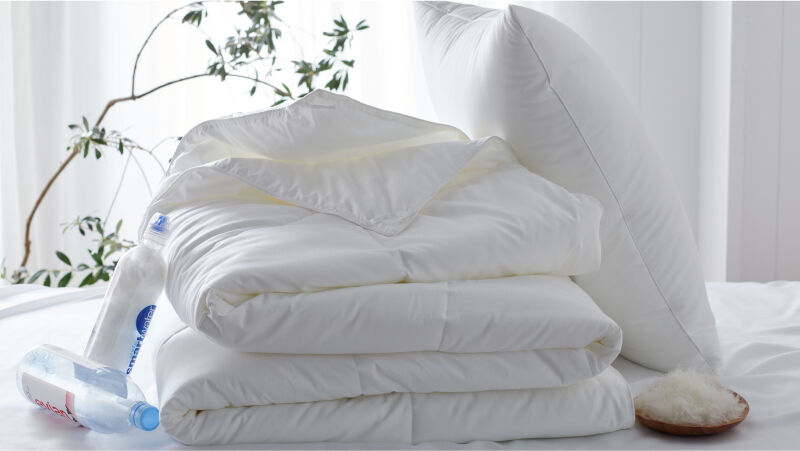Choosing Sustainable Bedding for Greener Sleep
With eco-friendly bedding, making a positive impact is so easy you can do it in your sleep. From choosing comforters to buying blankets, each bedding choice you make can be one you feel good about. Explore our guide and learn how to identify—and decide between—environmentally conscious choices when buying sustainable bedding.
Eco-Friendly vs. Natural vs. Organic vs. Sustainable
Eco-friendly, natural, organic, sustainable—these are all terms eco-conscious shoppers spot in their search for bedding. But what exactly do they mean, and how do they differ? Let’s break it down.
- Eco-friendly describes any product, process, or behavior that does not harm the Earth.
- Natural materials are those that come from the Earth, plants, or animals.
- Organic products carry certification that they are produced without the use of fertilizers, pesticides, and other synthetic chemicals that could harm the environment.
- Sustainability looks holistically at a product’s life cycle to determine its current and future impact: sustainable products aim to minimize harm to the Earth now—and to avoid compromising the ability of future generations to meet their needs.
Sustainable Materials for an Eco-Conscious Bed
Bedding that is good for the planet—and good for you—is made from natural materials like classic organic cotton, linen, or bamboo. Whether you’re choosing sheets, comforters, or blankets, here are the top textiles for sustainable living:
- Certified organic cotton comforters, sheets, and other bedding are made from responsibly sourced, washed, and dyed cotton grown in an environment free from pesticides, chemical fertilizers, or herbicides. Breathable, soft, and durable organic cotton is used to make warm flannel, crisp, cool percale, and smooth sateen.
- Linen is a natural fiber derived from the flax plant. It grows well without pesticides and fertilizers, requires little water to grow or process, and is made using all parts of the plant. Breathable, moisture-wicking linen is biodegradable but strong, and it gets softer each time it’s washed.
- TENCEL™ Lyocell is sustainable and eco-friendly. It’s produced using environmentally sound, closed-loop production processes from sustainably sourced wood pulp and is biodegradable upon disposal. Breathable, moisture-wicking TENCEL™ Lyocell is silky soft and cool to the touch.
- Rayon made from bamboo products are not always eco-friendly, but can be—if they’re made without harsh chemicals. Rayon made from bamboo blend bedding is often made with renewable bamboo and cotton or sustainable TENCEL™ Lyocell to create a durable textile that’s buttery soft.
- Wool is moisture wicking, incredibly breathable, and extremely warm—perfect for keeping cozy in cold temperatures. Because sheep regrow their fleece every year, wool is a naturally renewable fiber source, and when made without harmful dyes, it is biodegradable in both land and water.
Did You Know: Our bedding undergoes extensive third-party testing to ensure it meets the highest ethical and environmental standards. Look for OEKO-TEX a, Global Organic Textile Standard (GOTS), Responsible Down Standard (RDS), and other eco-friendly certifications on sustainable bedding from The Company Store.
Are Down and Down Alternative Comforters Eco-Friendly?
Like all of our products, our down and down alternative comforters are made with an emphasis on ethical and environmental responsibility. Look for down comforters, blankets, and pillows filled with duck or goose down that’s certified under the Responsible Down Standard (RDS), a voluntary standard crafted with the input of animal welfare groups to ensure the humane treatment of fowl. For those who prefer an animal-free option, PrimaLoft® Down Alternative Fill is a warm, breathable, lofty synthetic made with post-consumer recycled materials—specifically, water bottles that have been diverted from landfills.

Our most sustainable product yet, our Company Conscious™ comforters (and pillows to match) feature an eco-friendly TENCEL™ Lyocell and cotton shell filled with waste-reducing recycled down or synthetic fill made with recycled water bottles and TENCEL™ fiber.
4 Principles for Eco-Friendly Bedding
Ready to build a sustainable bed that’s better for the planet? Follow these four simple principles to create a space you can feel good about snuggling up in.
Unless you’re starting from scratch, you don’t need to switch to sustainable bedding all at once. Replace your current bedding with sustainable options one piece at a time so you’re not unnecessarily sending old items to the landfill. Better yet: donate gently used bedding to an organization that can reuse or resell it.
Tip: Wondering what to do with worn out or stained bedding? Don’t toss it! Instead, donate it to an animal shelter, where it can help keep your favorite four-legged creatures cozy.
High-quality bedding may seem like a splurge, but it’s your best bet for sustainability. Whether it’s an organic down comforter that’s ethically and environmentally sound or a set of eco-friendly Supima® Cotton sheets, high-quality bedding offers long-term value: it’s made to last, so it will need to be replaced less frequently—a win for the planet and your wallet.
Time for a bedroom refresh? Choose a comforter filled with eco-friendly down or down alternatives that are responsibly sourced and produced. Already own a comforter? Instead of buying multiple comforters, consider a duvet cover you can simply slip over your existing bedding for a new look, instantly. Duvet covers require fewer resources to make—no fill necessary—and to wash; because you’ll only need to regularly launder the cover (not the bulky insert), you’ll save water and energy.

Think beyond organic comforter sets or duvets and incorporate eco-friendly options in as many bedding layers as possible: start with organic cotton sheets or options crafted in TENCEL™ Lyocell, lightweight linen, or a bamboo blend, then add a blanket crafted in high-quality, sustainable materials. Choose a breezy linen or bamboo-blend throw for summer months, or add a wool blanket when temperatures fall. For an extra-cozy, environmentally conscious layer that’s warm enough for even the coldest weather, opt for an eco-friendly duvet insert: ours are available in a range of weight options from super-light to extra-warm, so you can customize your bedding to match your preferred comfort level.
Eco-Friendly Laundry Tips
Laundry is essential, but not always eco-friendly. Give this necessary routine a sustainable makeover with our eco-friendly laundry tips:
- Wash cold whenever possible. Washing bedding and clothes with cold water saves on energy used for heating and reduces wear and tear on your items so they last longer.
- Only run the washer or dryer when you have a full load. Or, if you’re washing a smaller load, use the recommended washer setting to avoid excess water use.
- Air dry bedding on clotheslines or drying racks. When using a dryer is necessary, adding wool dryer balls can reduce dry time.
- Choose textiles made with natural, biodegradable materials. Because fabrics naturally shed their fibers when washed, you’ll want them to quickly decompose in the water system.
- Skip fabric softener and dryer sheets. They are full of synthetic chemicals that can reduce the lifespan of your bedding and leach into your water supply, harming the environment.
Sustainability is not an all-or-nothing endeavor. Whether you invest in an eco-friendly down comforter or begin washing your bedding on cold cycles only, even making one small change to your choices can have a positive impact on the environment. Sleep soundly with these sustainable bedding tips, and find more tips and ideas in our other Guides.